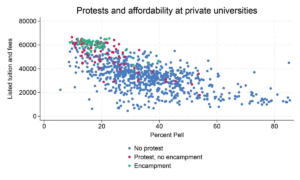Washington Monthly decided to check an interesting hypothesis:
“Have pro-Palestinian protests taken place disproportionately at elite colleges, where few students come from lower-income families?”
“The answer,” they found, “is a resounding yes.”
They used the percent of students on Pell Grants as a proxy for low to middle-income students, and found this remarkable relationship between student family incomes and anti-Israel activity:
A few outliers exist, such as Cal State Los Angeles, the City College of New York, and Rutgers University–Newark. But in the vast majority of cases, campuses that educate students mostly from working-class backgrounds have not had any protest activity.
For example, at the 78 historically Black colleges and universities (HBCUs) on the Monthly’s list, 64 percent of the students, on average, receive Pell Grants. Yet according to our data, none of those institutions have had encampments and only nine have had protests, a significantly lower rate than non-HBCU schools.
Protest activity has been common, however, at elite schools with both low acceptance rates and few Pell students…

